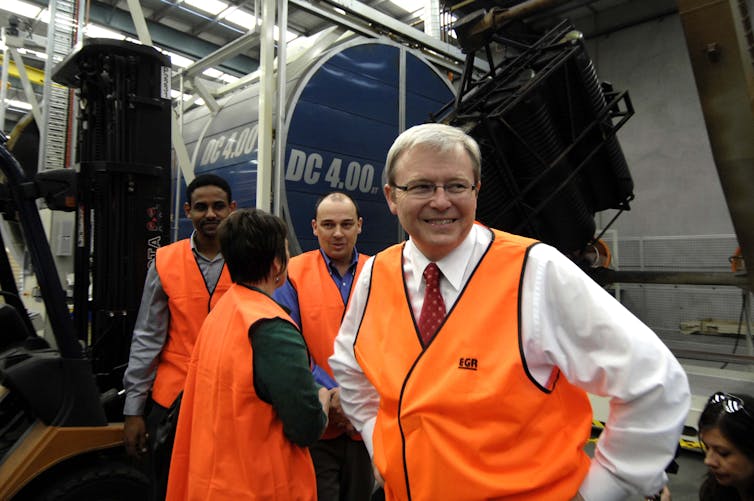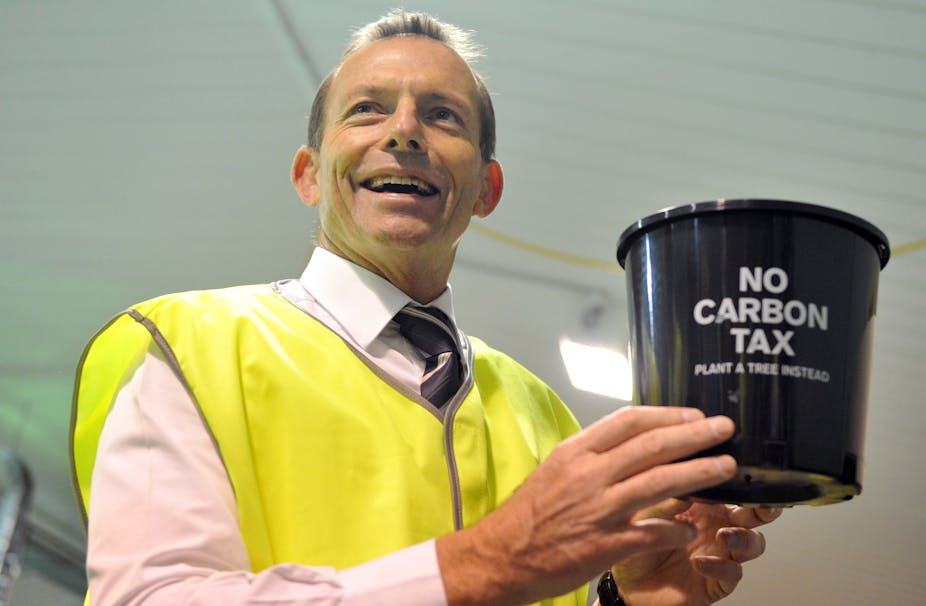Election 2013 Essays: As the federal election campaign draws to a close, The Conversation asked eminent thinkers to reflect on the state of the nation and the challenges Australia – and whichever party wins government – faces in the future. Today, Colm Harmon discusses the true deficit of this campaign: clear, rational economic thinking and policy.
As we enter the final stretch and look over the campaign that was election 2013, we see a period of political and social debate brimming with rich economic thinking as politicians plan their way forward for Australia, right?
Er, no actually.
The election has been remarkably light on any serious effort to debate economics at a time when the economy should have been the cornerstone of the whole campaign.
Economics figured solidly as the firing pistol sounded. Prime minister Kevin Rudd provided a rather downbeat assessment of the economy in transition, coupled with a series of political clichés about improving productivity and replacing the mining boom.
In response, the Coalition locked into the portrayal of Labor as a party of spendthrifts, frittering away the Howard era but perhaps forgetting the global financial crisis that came in between.
However, both parties were aware that the world had changed, and in some respects the macroeconomy was now in the hands of the gods. This suggested that the campaign would unfold in line with this starting point – a global macroeconomic context and a focus on smart microeconomic policy to promote better distributive outcomes for society.
Labor would flesh out their ideas to promote workforce flexibility while also promoting workplace protection. They would finally begin to join up the dots on their education policy to promote enhanced productivity. The Coalition would look to promote less waste, less regulation.
This has just not evolved.
What actually followed has been a whirlwind tour-de-force presentation of clientalist politics of the worst kind – a dollop here, a dollop there, the prime minister and prime minister-in-waiting hanging out in fluoro vests and hard hats at manufacturing facilities, talking up a sector which has shrunk as a contributor to the Australian economy over the past decade.
Neither side has delivered a serious policy option that is remotely close to being inspiring. To some extent, Labor doesn’t have to. They came into the campaign with a suite of policy options on the table and with no real reason to change them.
The Coalition, on the other hand (or rather their leader), unleashed a fanciful paid parental leave (PPL) policy. This, it must be said, is just plain old vanilla bad policy. It costs a fortune, and while paid parental leave is in general a policy that promotes many economic benefits, the PPL policy proposed by Tony Abbott will be riddled with what economists call “deadweight”.
Higher earning, higher educated women – the main beneficiaries - will have as many children and be as likely to return to work under either the Labor or Coalition policy - but for massive extra costs under the Coalition plan. Lower-income women will be no more likely to return to work because of PPL, as that is not the pinch point – childcare is. It is a total mess of an idea and regrettably ill-thought out.
Oddly, the attempt to use PPL to get the voting middle on side has backfired. The polling on the Coalition PPL policy suggests that it does not have the sort of backing that might have been expected from the middle class vote.
And that, perhaps, is the real message of the 2013 federal election when it comes to economics. The electorate is a good deal savvier to the reality of what is going on than the politicians give them credit for, but instead are treated to what is a quite superficial presentation of the arguments.
The other dominant jostling has been over costings of policies with both sides goading each other over the details – or lack thereof – behind their plans and the potential “budget blowouts”. Through fluke rather then design, largely as a means of offsetting the negative campaign portrayal of the LNP as “austerians” but partly to reflect the dawning reality of where the economy is sitting right now, the latter period of the campaign has taken the return to surplus off the agenda from both sides, and more importantly has killed off the faux austerity discussion.
The surplus promise is important – as noted in an insightful essay by UNSW’s Geoff Garrett. Australia does not have a public debt problem, and does not need to behave as if it has.
There is now a unique opportunity to reshape the economy. This “glass half full” perspective does treat the end of the mining era as a move to a new equilibrium, and the war chest is ample enough to avoid the need for a slash and burn budget on the expenditure side.
However, the economy is not strong enough, thankfully, to have the resources to provide stimulus. Perhaps it is an example of one of those laws of unintended consequences at work, but this fiscal straightjacket stops politicians from doing crazy things.

Institutions in Australia are also relatively strong. The Reserve Bank has shown itself to be responsive to the global economic situation. It has sister agencies, such as the Australian Prudential Regulation Authority, that have kept the banking sector from the sort of bonkers decision-making that so many other countries have suffered under (even if the Australian banking sector remains uncompetitive). The much-maligned Treasury has a very clear perspective on where things are going. Again, the macroeconomy is in the hands of folks who know what they are doing.
In short, the economy is, in my view, landing relatively softly. But to extend the analogy, it also has enough runway to gather pace and take off again.
In macroeconomic terms, the global economy has moved into a different space, with the tapering of quantitative easing in the United States poised to deliver, inadvertently, a stimulus to Australia through its impact on the Aussie dollar. That leaves the burden of the transition to that new equilibrium as coming from smart and clever microeconomic policy. Few of the potential options have come to light in the campaign with little serious presentation of credible, well-articulated policies.
For the Coalition, the paid parental leave idea and loopholes around health insurance are middle-class perks that are millstones that will need to be dumped fast. Far too much energy is going into finding the money for these plans. Both sides will need to examine swiftly the range of bizarre restrictive practices such as parallel importing in key markets.
Both sides also need to avoid the idea that selling houses to each other to get rich again is a good idea. The key policy areas of health and education need a strong effort to get alignment of motive and desired outcome – robbing one education sector to pay for the experiences of another (as in the Gonski schools funding review) is a very short sighted plan.
To give them credit, the Coalition is the only party giving serious consideration to the revenue side of the budget. A commitment to a review of the Goods and Services Tax (GST) option with a view to going to the country in 2016 with a policy on increasing the GST would be a smart move. It sensitises the electorate to what is coming, but I suspect the options on GST and other elements of the tax base (including deeper examinations of the tax loopholes in property and other investment) will actually happen sooner and in the life of the next parliament.
All in all, this has been a pretty muted affair in the economics space in terms of tangible, coherent policy choices.
This is the third article in our Election 2013 Essays series. Stay tuned for the other instalments in the lead-up to Saturday’s election.
Part one: Australia and the world
Part two: The state of Australian democracy
Part four: What is government for?
Part five: The philosophy of voting
Part six: Australia for the long term

